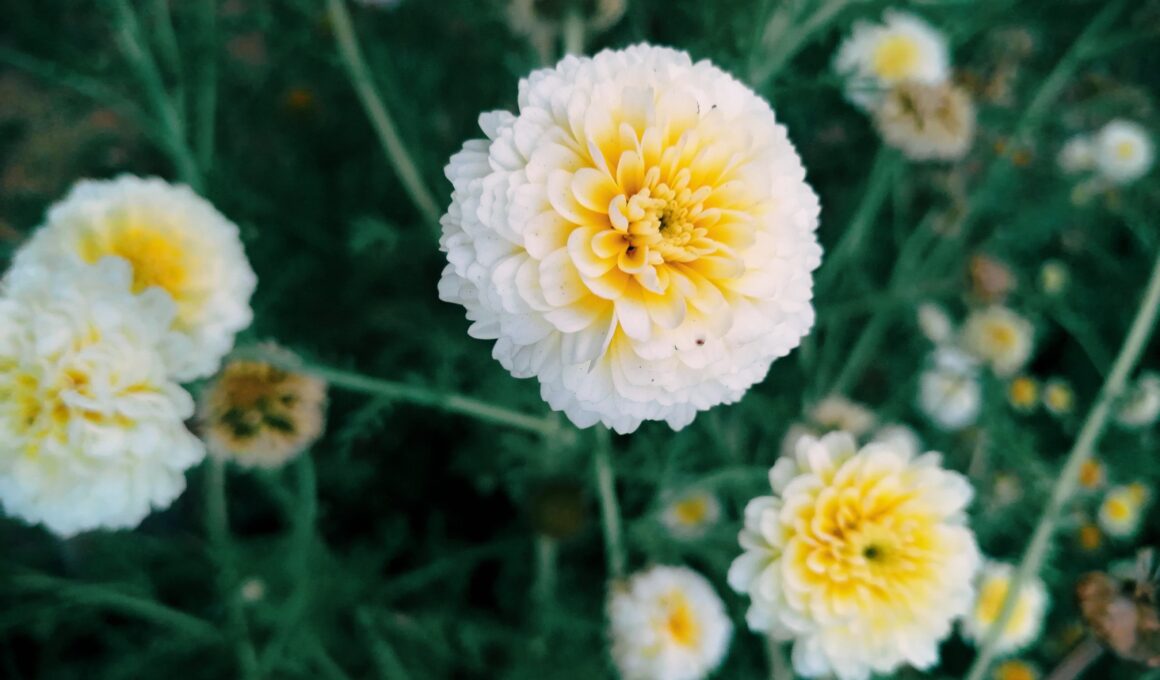Key Takeaways
- White marigolds add elegance to any garden with their pure white petals and vibrant green leaves.
- Choosing the right location with at least six hours of direct sunlight and free from hazards is important for growing healthy white marigolds.
- Proper soil preparation, including removing debris and rocks and enriching with organic matter, is crucial for the growth of white marigolds.
- Regularly checking for pests and diseases, providing balanced fertilizer, and maintaining proper watering techniques are essential for the successful growth of white marigolds.
Choosing the Right Location for Planting
You’ll want to find a sunny spot in your garden where your white marigolds can bask in at least six hours of direct sunlight each day – imagine them soaking up the rays like a sunbather at the beach. It’s crucial that you choose the right location for planting. Without sufficient sunlight, your white marigolds may not bloom as beautifully as they could. Think safety first when you’re selecting a spot to plant marigold. The area should be free from hazards that might interfere with their growth, such as sharp objects, toxic plants, or excessively rocky soil. It’s also a good idea to keep them away from areas frequently used by children or pets, as their delicate flowers could easily get damaged. Choosing the right location for planting your white marigolds also involves considering the quality of the soil. They prefer well-drained soil that isn’t too rich. If the soil in your chosen spot is poor, don’t worry. You can always amend it with compost or a slow-release fertilizer to give your marigolds the nutrients they need. Remember, the spot you choose for your white marigolds can significantly influence how well they grow and bloom. Choose wisely and your marigolds will thank you with their bright, cheerful blooms.Preparing the Soil for Seedlings
Before you even think about planting, it’s crucial to thoroughly prepare your soil. This involves enriching it with organic matter and ensuring it drains well to give your seedlings the best possible start. Preparing the soil for seedlings is a task that requires attention and care, much like your white marigolds will. Firstly, remove any debris or large rocks from the soil. These could impede your seedlings’ growth and become obstacles for their roots. Once the soil is clear, it’s time to work in some organic matter. Compost, well-rotted manure, or leaf mold will not only give your seedlings plenty of nutrients to feed on but also improve your soil’s structure and its ability to retain moisture. Next, check your soil’s drainage. Marigold seedlings dislike waterlogged soil. To test, dig a hole about 6 inches deep and fill it with water. If it drains within an hour, your soil is perfect. If not, you might need to add some sand or grit to improve its drainage. Remember, your white marigold’s success starts with healthy soil. Nurture your soil, and it will, in turn, nurture your seedlings, ensuring they grow into beautiful, flourishing plants.Understanding the Planting Process
Imagining the day when your garden blooms with vibrant beauty, it’s time to get your hands dirty and start the planting process. With an understanding of the planting process, growing white marigolds can be a rewarding experience. Here is a simple guide to make this task manageable and safe:| Steps | Description | Safety Measures |
|---|---|---|
| 1. Planting | Plant seeds about 1 inch deep and 2 inches apart. | Use gloves to protect your hands. |
| 2. Watering | Water the marigolds regularly, but avoid overwatering. | Be careful not to slip on wet soil. |
| 3. Sunlight | Marigolds need a lot of sunlight. | Use sunscreen and wear a hat when gardening. |
| 4. Care | Regularly check for pests and diseases. | Use organic and safe pest control methods. |
Nourishing Your Flowers with Proper Fertilization
Ensuring your flowers are well-nourished isn’t just about watering them, it’s also about providing the right fertilization, and that’s where we’re focusing next. To grow marigolds, especially white marigold, you need to understand the importance of nourishing your flowers with proper fertilization. Let’s start by identifying what type of fertilizer is best for your marigolds. They typically thrive with a balanced fertilizer, one that has equal proportions of Nitrogen, Phosphorus, and Potassium (N-P-K). You can find these ratios on the fertilizer bag, and a 10-10-10 or 14-14-14 mix is ideal. Apply the fertilizer in the early stages of growth, and then every 4-6 weeks. Always be sure to follow the manufacturer’s instructions to maintain a safe environment. Over-fertilization can lead to lush foliage but few blooms, so moderation is key. Remember, your white marigolds depend on you for their nourishment. Proper fertilization not only ensures their health, but also enhances their beauty. Keep these tips in mind and you’ll be one step closer to growing flourishing, vibrant white marigolds.Watering Techniques for Healthy Growth
Proper watering techniques are another crucial factor in nurturing your flowers to their full potential. As you grow marigold, especially the white variety, it’s essential to keep the soil moist but not waterlogged. Overwatering can be as harmful to your marigolds as underwatering. Here’s a list of watering techniques for healthy growth:- Water your flowers early in the morning or late in the evening when temperatures are cooler. This helps to reduce water evaporation.
- Consider using a soaker hose or drip irrigation system to deliver water directly to the root zone of your plants.
- Avoid overhead watering, as this can lead to the spread of disease and can damage the delicate petals of your white marigolds.
- Check the soil moisture regularly. If the top inch of soil feels dry, it’s time to water your plants.
- Remember, marigolds are drought-tolerant plants, so it’s better to under-water than over-water. By following these tips, you can ensure that your white marigolds receive the right amount of water they need to thrive.
- Keep monitoring the moisture levels of the soil and adjust your watering techniques as necessary. That’s the way to nurture your flowers to their full potential.
Picking the Right Time for Planting
Choosing the ideal planting time for your flowers is key to their overall health and success. When it comes to white marigolds, picking the right time for planting is indeed essential. You can’t just plant marigold seeds anytime you wish. There’s a certain time frame that works best for these lovely flowers. To understand better, let’s look at some essential factors to consider:| Factor | Ideal Time |
|---|---|
| Temperature | 70-75 degree Fahrenheit |
| Season | Spring |
| Sunlight | Full sun |
| Soil Condition | Well-draining soil |
| Seedling Tray | Use 4-6 weeks before the last frost date |
Maintaining Your Flower Bed
After you’ve got those seeds in the ground, it’s time to show your flower bed some love and attention to keep it looking its best. Maintaining your flower bed isn’t as daunting as it may sound, especially with the resilient marigold plant. Water your marigolds deeply, about once a week, depending on the weather. In hotter conditions, they may need a little extra. However, be careful not to overwater, as this can lead to root rot. Ensure your marigold plants get at least six hours of sunlight daily. They love the sun, and adequate exposure promotes healthy growth. Regularly check for pests, such as aphids and whiteflies. Safety is key, so opt for organic pest control methods rather than chemical ones. When it comes to feeding your flower, a well-balanced fertilizer is your best bet. Use it sparingly, though, as too much can harm your plant. Remember, marigolds are robust and don’t require excessive pampering. Your dedication to maintaining your flower bed will pay off when you see the stunning white blossoms of your marigold plants. Their radiant beauty will be a testament to your tender care and green thumb.Preventing Common Pests and Diseases
Keeping your garden free of pests and diseases is a crucial part of ensuring your vibrant white marigolds continue to bloom beautifully. This task might seem daunting, but it’s possible with some vigilance and the right approach. Not only will you be protecting your flowers, but also creating a safe and healthy environment in your garden. Be proactive in watching out for signs of spider mites. These tiny pests can cause significant damage to your white marigolds. Look for fine webbing or stippling on your plants. If you spot them, a natural miticide can help. Powdery mildew often forms a white, powdery film on the leaves. This can be prevented by ensuring good air circulation and not overwatering your plants. Introduce beneficial insects like ladybugs and lacewings. They’re not only charming additions to your garden but also natural predators of harmful pests. Regularly inspect your plants. Catching any issues early is key to preventing the spread of disease and pest infestations. Remember, it’s about more than just keeping your garden looking its best. It’s about creating a sanctuary where nature can thrive safely. This is your garden, your sanctuary. Keep it safe and let it bloom.Harvesting Seeds for Future Planting
You’ll find a whole world of joy in harvesting your own seeds for future planting, turning the cycle of life in your garden into a rewarding, hands-on experience. White marigold seeds are particularly easy to harvest and save for future planting. First, wait until the marigold flowers dry out and turn brown on the plant. This indicates that the seeds are fully mature and ready for harvesting. You’ll be able to recognize the seeds as they’re slender, dark, and slightly curved. To harvest, simply pull the seeds gently from the base of the flower and place them on a paper towel. Be gentle to avoid any damage to the seeds. Once you’ve collected enough, carefully transfer the seeds to a seed packet or an envelope. Make sure to label them correctly with the variety and the year of harvesting. This helps in organizing your seed collection and ensures you’ll remember what you’re planting next year. Remember to store your seed packet in a cool, dry place away from direct sunlight. This helps keep the seeds viable and ready for future planting. With these simple steps, you’ll enjoy a continuous cycle of beautiful white marigolds in your garden.Enjoying the Blooms: Care and Preservation
Once your seeds have sprouted into vibrant blooms, it’s essential to know how to care for and preserve them so they can continue to brighten up your garden. White marigolds are not just visually appealing but are also simple to maintain. With a few safety measures, you can ensure they remain healthy and produce abundant blooms. Firstly, ensure your white marigolds receive full sun. These lovely flowers thrive in bright light. Regular watering is also crucial, but avoid over-soaking as this may lead to root rot. On hot summer days, it’s best to water them early in the morning or late in the evening to reduce evaporation. To encourage abundant blooms, feed your white marigolds with a balanced, slow-release fertilizer every four to six weeks. This will provide them with the nutrients they need to flourish. Regularly deadhead spent flowers to stimulate new bloom production. This is a safe and easy way to keep your white marigolds blooming beautifully. Protecting your white marigolds from pests is also vital. Inspect your plants regularly and if you notice any signs of disease or pest activity, treat them immediately with an appropriate organic or chemical solution. Remember, a healthy plant is a happy plant!How do I grow white marigold?
To grow white marigolds, you can start by planting marigold seeds indoors. Learn how to grow marigolds from seed and care for marigolds to ensure they thrive with the above guide.What are some tips for growing marigolds?
Marigolds are easy to grow and care for. Here are some tips: start marigold seeds indoors weeks before your last frost date, sow the seeds indoors, and allow the soil to dry between waterings.Can I transplant marigolds?
Yes, you can transplant marigolds. Once the danger of frost has passed, you can transplant the marigold seedlings outdoors.Can I grow marigolds indoors in containers?
Yes, you can grow marigolds indoors in containers. Marigolds are easy to grow from seed and they make great indoor plants.How tall do marigolds grow?
Marigolds can grow to be 10 to 12 inches tall, depending on the variety.Can marigolds be used as companion plants?
Yes, marigolds are often used as companion plants in vegetable gardens. They can repel pests and improve the overall health of the garden.Can I save seeds from marigolds?
Yes, you can save seeds from marigolds. Allow the flowers to fully mature and dry on the plant, then collect the seeds for future planting.Can White Marigolds Bloom for a Long Time?
White marigolds have captivated gardeners with their unique beauty. But can these blossoms maintain their charm for an extended period? In this longest blooming perennial article, we delve into the lifespan of white marigolds. Discover how diligent care, proper soil conditions, and regular deadheading can contribute to their continuous, stunning blooms throughout the season.








